15 Reasons Why Your Cat Drools When You Pet Him?
Picture this: you’re sitting on your favorite couch, stroking your beloved feline friend with gentle, loving strokes. Suddenly, you notice a tiny pool of drool forming on your lap, courtesy of your purring companion. Now, you’re with the question- why does my cat drool when I pet him?
When your cat drools while you pet them, it’s often a sign of happiness, contentment, and relaxation, like how they felt nursing from their mother. Their facial muscles relax whenever they reach a point of utter comfort, causing saliva to escape. This is normal unless it’s excessive or comes with other worries. Sometimes, a bitter taste from medication or catnip can cause drooling too. In that case, giving them water or a treat might help. If this only happens while petting and not constantly, it’s usually okay. But if eating behavior, or mouth health changes, you should consult a vet.
As you can see, there is no single answer to this question, and a lot more to discuss. Through this blog, we tried to cover everything related to this topic and the things that might help the other cat parents. So. Let’s continue.
Interested in similar topics on cats:
Cats Drooling Behavior
Cats can drool for various reasons, and while some drooling is considered normal, some may indicate an underlying issue. Here are some factors that can help you to identify the difference:

Differentiating Between Normal Drooling and Problematic Drooling
Normal drooling occurs occasionally and is typically triggered by excitement, purring, kneading, or grooming. Problematic drooling, on the other hand, is extreme and persistent, often accompanied by other symptoms like bad breath, difficulty eating, or weight loss.
Unnatural drooling can indicate dental problems, oral infections, tumors, or underlying systemic diseases. And some cats may drool more than others.
Certain breeds, such as Persians and Himalayans, are more prone to excessive drooling due to their facial anatomy and shortened muzzles in response to stress, anxiety, or motion sickness. Age can also affect drooling levels in cats.
Usual Reasons Why Does My Cat Drooling When I Pet Him?
When your cat drools because of petting, it’s best to understand the possible reasons behind this behavior. As we mentioned in the previous point, some drooling might signal an underlying problem.

Here are common explanations for why your cat may drool during petting.
1. Happy and Contentment
Do cats drool when happy, or do cats drool with pleasure? Yes, some cats drool when they are happy. This is because they feel soothed, relaxed, or content. It’s believed that the pleasurable sensations they experience during petting or affectionate moments may trigger this response.
But not all cats drool when happy; some may start or stop drooling as they age. Happy drooling is usually harmless and normal for cats.
2. Relaxation
Cats may also drool if they are in a state of deep relaxation and tranquility. Being in a calm and peaceful environment can elicit this response.
So, why does my cat drool when relaxed? Because they become pleased and at ease. In general, this is normal and nothing to be concerned about.
3. Stimulation of Salivary Glands
Petting your cat can stimulate its salivary glands, leading to increased saliva production and drooling. It’s a natural physiological response, especially when the petting is focused around the chin and jawline.

4. Afraid
In some cases, cats may drool if they are afraid or anxious. Stressful situations or unfamiliar environments can trigger this response as a sign of their distress.
5. Catnip
Catnip, a herb that many cats find stimulating, can cause excessive drooling in some individuals. The active compounds in catnip can elicit this behavior when cats come into contact with or consume it.
6. Past Trauma\ Anxiety
Cats who have experienced past trauma or suffer from anxiety may drool as a result of their emotional distress. This can occur during interactions that remind them of previous negative experiences.
7. Bitter Taste
If your cat encounters a bitter or unpleasant taste, it may drool in response to try to eliminate the taste from its mouth.
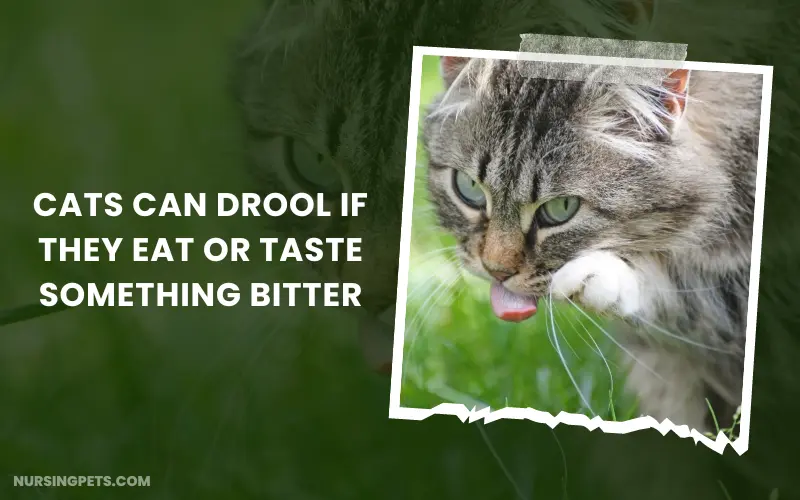
8. Motion Sickness
Some cats drool when they experience motion sickness, such as during car rides. The motion and change in equilibrium can trigger abundant oral moisture production and subsequent drooling.
These are the usual and normal reasons that can lead to drolling behavior in cats. And mostly, there is nothing to worry about if drooling occurs for these.
Potential Medical Issues Associated with Cat Drooling
Cat drooling can be indicative of various medical issues that require attention. Here are potential medical problems associated with cat drooling:
9. Dental Problems and Oral Infections
Dental conditions like gum disease, tooth decay, or oral infections can cause abundant oral moisture in cats. Inflamed gums, loose teeth, or oral discomfort can contribute to increased saliva production.
10. Pain or Discomfort
Cats in pain or discomfort can drool as a reflexive response. Dental issues, oral injuries, or other underlying health problems can contribute to this type of drooling.
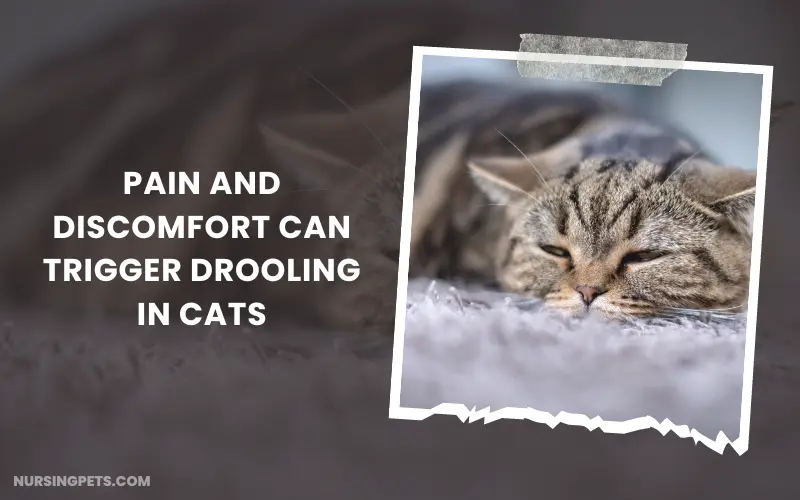
11. Mouth Injuries or Unwanted Debris
Injuries to the mouth can result in drooling, such as cuts, burns, or the presence of foreign objects that become stuck in their mouths or throats. Cats may drool as a response to soothe the affected area or to try to remove non-native items.
12. Toxins and Poisonous Substances
Ingesting toxic or poisonous substances can lead to excessive drooling in cats. Certain plants, chemicals, or medications can be toxic and cause salivation as a protective mechanism.
13. Upper Respiratory Infections
These can affect cats and are often caused by viruses such as feline herpesvirus or calicivirus. Cats with these infections may exhibit respiratory symptoms like sneezing, nasal discharge, coughing, and increased drooling.
13. Gastrointestinal Issues
Cats can experience drooling as a result of various digestive issues. Circumstances like nausea, acid reflux, or inflammatory bowel disease can assist with this symptom. With these problems, the kitty may exhibit other symptoms such as vomiting, diarrhea, or a reduced appetite.
14. Neurological Conditions
Certain neurological disorders or abnormalities can affect the nerves controlling saliva production, leading to increased drooling in cats. Examples include vestibular disease, facial nerve paralysis, or brain tumors.

15. Heatstroke
Cats experience heatstroke in hot weather or when exposed to high temperatures. Excessive drooling, panting, lethargy, and distress are common signs of heatstroke and require immediate veterinary attention.
16. Digestive Issues
Digestive problems can cause drooling in cats. This is because they may feel nauseous or have been vomiting. Some possible causes of nausea in cats are gastrointestinal upsets, kidney disease, liver disease, or foreign body blockage.
When your cat has a foreign body stuck in their stomach or intestine, it may drool. If this is the case, they may also have a poor appetite or show signs of pain or discomfort.
These are concerning situations if your cat is drooling from any of the above. Although the above-mentioned medical reasons are not common, these can also be the case.
When Should I Be Concerned or Visit a Vet About My Cat’s Drooling?
Recognizing the signs of concern in your cat’s drooling ensures their well-being. If you notice any of the following indicators, it’s important to consider visiting a veterinarian:
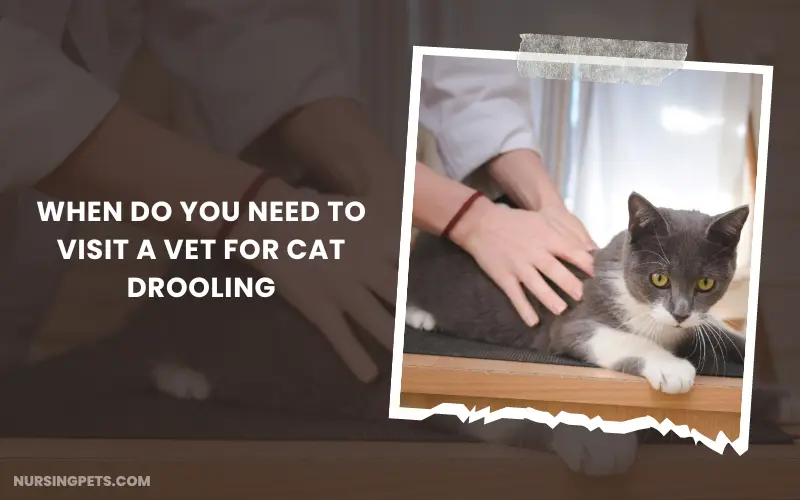
Sudden Onset
If your cat starts drooling unduly, it may indicate an underlying issue that needs veterinary attention. Abrupt changes in drooling patterns can be a cause for concern.
Excessive Drooling
While some cats naturally drool a little, extreme drooling beyond their normal behavior should be investigated. If your cat is soaking their fur, leaving wet spots, or constantly wiping their mouth, it’s a red flag that something may be wrong.
Signs of Discomfort, Oral Pain, or Mouth Injury
Drooling accompanied by indications of oral discomfort, such as pawing at the mouth, vocalizing while eating, reluctance to eat, or bleeding from the mouth, should be taken seriously. These signs might suggest dental issues, mouth injuries, or oral infections.

Exposure to Toxins
Drooling can be a symptom of poisoning in cats. If you suspect your feline has come into contact with toxic substances like household cleaners, plants, pesticides, or human medications, seek immediate veterinary care, as some toxins can be life-threatening.
Medical Issues
Excessive drooling in cats can result from infections like respiratory or dental, oral ulcers, gum inflammation (gingivitis), mouth inflammation (stomatitis), foreign objects lodged, or salivary gland issues, and the others mentioned above.
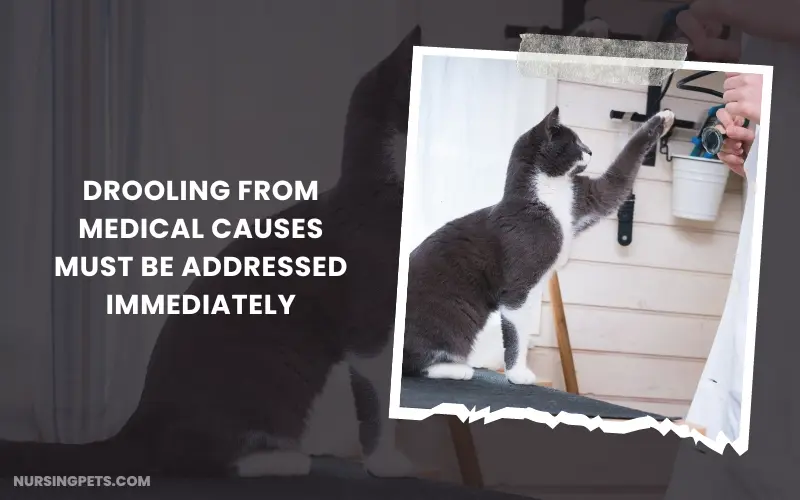
A professional must look into your cat and provide the necessary treatment and future guidelines.
Difficulty Eating or Swallowing
If your cat is experiencing difficulties while eating, swallowing, or displaying a sudden aversion to food, it could be related to their drooling. Such problems might indicate an obstruction, inflammation, or an issue with the throat, esophagus, or digestive system that warrants veterinary evaluation.
Therefore, if you notice or identify the drooling behavior is caused by the above, this is concerning, and your cat needs immediate medical care.
How to Prevent Excessive Drooling in Cats?
If the drooling isn’t from any medical conditions, it is not much of a concern. But if your cat is drooling excessively, you can provide some care that can help to improve the situation.
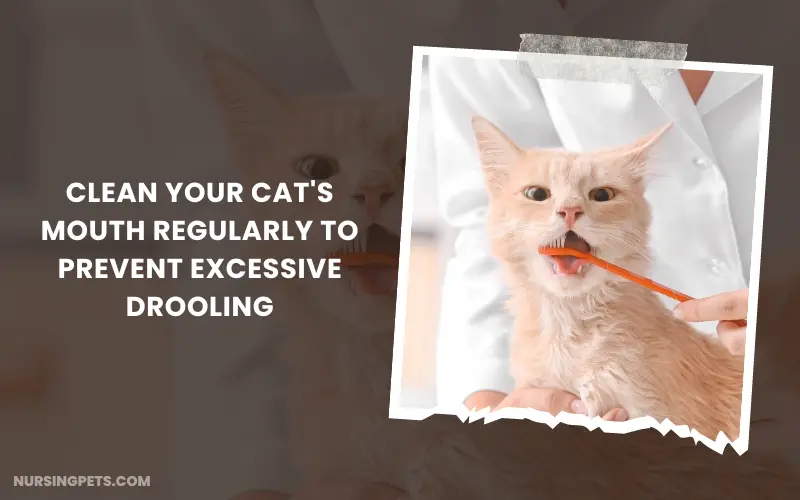
Here are valuable tips to keep your furry companion comfortable and drool-free:
Dental Care
Maintain oral hygiene to prevent drooling issues. Regularly brush your cat’s teeth with vet-recommended toothbrush and paste. Dental cleanings under vet supervision might be needed. Your cat’s dental care matters!
Healthy Diet
Nourish your cat with a well-balanced diet to safeguard oral health. Opt for high-quality cat food enriched with dental-friendly nutrients. Crunchy kibbles can aid in tartar control. Adequate water intake further supports oral hygiene.
Environmental Safety
Create a secure place for your cat by eliminating risks and potentially hazardous items. Identify and remove toxic plants, chemicals, or ingestible threats from your living space. Protecting your cat from harmful substances is crucial in preventing drooling triggered by toxin exposure.
Stress Reduction
Cats can experience stress, which can manifest in various ways, including excessive drooling. Create a calm and stress-free environment for your cat by providing hiding spots, engaging in interactive play, and maintaining a consistent routine.
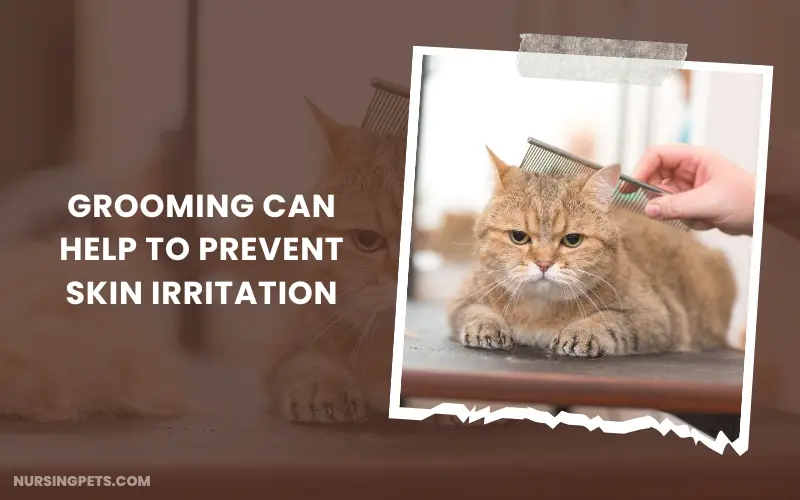
Regular Grooming
Regular grooming sessions can help keep your cat’s coat clean and prevent drooling caused by discomfort from matting or skin irritation. Brushing your cat’s fur and keeping it free from tangles and debris can contribute to its overall comfort.
Monitor for Signs of Discomfort
Stay watchful and attuned to your cat’s well-being. Observe for oral discomfort, unusual behavior, or signs of distress. Routinely examine their mouth for redness, swelling, or sores.
Regular Veterinary Check-ups
Schedule regular check-ups with your veterinarian to monitor your cat’s oral health and overall well-being. Routine dental examinations can catch any potential issues early on and prevent them from progressing into more serious conditions.
Is Cat Drool Harmful to Humans?
Cat drool usually poses no harm to humans, yet proper hygiene is essential. When handling it, keep these points in mind for safety. Here’s what you need to know:
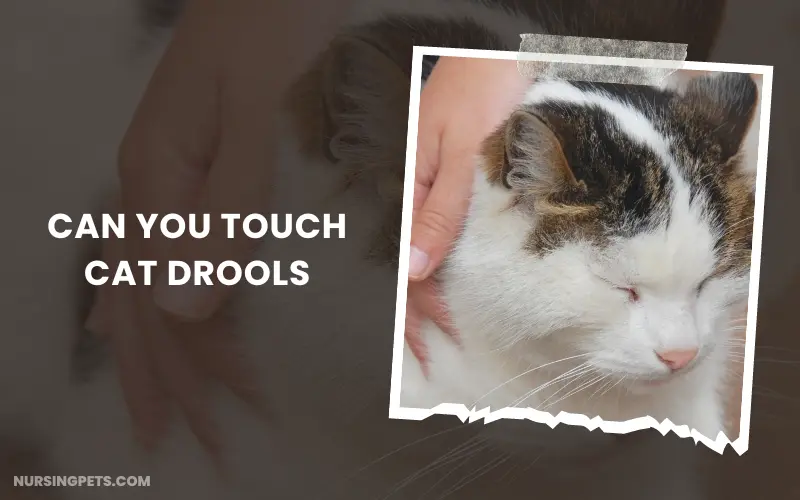
Is It Okay to Touch Cat Saliva?
Generally, cat saliva is safe to touch, but post-contact hand washing is wise, especially with cuts. Cats carry mouth bacteria, and although infection risks are minimal, prioritizing hygiene curbs potential concerns. So, both of you can coexist harmoniously with a touch of care.
Still, there could be some potential risks, and it could be harmful to some people. Those are:
Bacteria: While uncommon, specific cat mouth bacteria like Pasteurella multocida can lead to human infections, often through bites or scratches rather than saliva contact.
Individuals with strong immune systems generally face minimal complications. Stay careful during play and receive swift medical attention if bitten or scratched.
Immunocompromised Individuals: People with compromised immune systems, like those in chemotherapy or with specific health issues, could face higher infection susceptibility.
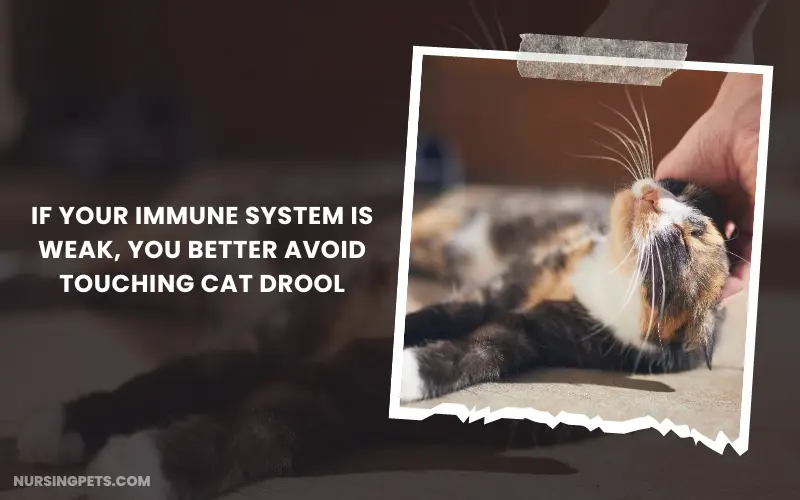
For them, added vigilance and expert guidance are recommended. Consulting healthcare professionals to help assess potential risks and determine suitable precautions.
Allergies: For some individuals, cat saliva can trigger allergies, causing discomfort like sneezing, itching, or even asthma attacks. If you or others have known cat allergies, limit saliva contact. Regular cleaning, air filtration, and allergy medications can ease symptoms.
Frequently Asked Questions
1. Why Does My Cat Drool When He Purrs?
Cats drool while purring due to relaxation and contentment. Purring stimulates salivary glands, leading to drooling. Dental issues or excitement could play a role. It’s nothing to be overly concerned about unless accompanied by other concerning symptoms.
2. Do Cats Drool When They Love You?
Some cats drool as a loving gesture. It can reflect their strong attachment and comfort with you. However, not all cats show love this way; each has distinct ways of expressing affection.
3. Why Is My Cat Drooling Thick Saliva?
It might mean a few things if your cat starts drooling with thick saliva. Dental issues like gum disease or tooth infections could be a cause. Mouth ulcers, harmful consumption, respiratory infections, or an object lodged in the mouth could also be reasons.
4. Do Cat Drools Before Death?
In some cases, yes. Cats might drool before passing due to pain, swallowing difficulties, or organ problems. However, note that drooling alone does not indicate impending death.
Parting Words
If your cat drools while being pet, it’s a natural and positive response. It’s a sign of extreme contentment and relaxation. The tactile stimulation from your touch triggers the release of pleasurable endorphins, creating a blissful experience for your feline companion.
So, if your feline friend drools while you stroke them, it’s a clear indication that they trust you and are thoroughly enjoying the pampering session.
But as we mentioned, there could also be some concerning matters. And you need to identify what it is. However, if you are unable to tell, visit a professional to find out the exact reason.
References:
- “Cat Drooling: Causes, Symptoms, and Treatment.” PetMD, www.petmd.com/cat/symptoms/why-my-cat-drooling. Accessed 24 June 2023.
- “Why Do Cats Drool? Exploring the Causes and Solutions.” Insider, www.insider.com/guides/pets/why-do-cats-drool. Accessed 24 June 2023.
- “My Cat Drool When I Pet Them? Here’s What Vets Want You to Know.” POPSUGAR, www.popsugar.com/pets/why-does-my-cat-drool-when-i-pet-them-47829634. Accessed 24 June 2023.
- “Cat Drooling Everywhere: Common Reasons and Potential Solutions.” VetHelpDirect, vethelpdirect.com/vetblog/2018/10/16/cat-drooling-everywhere-reasons/#discussion. Accessed 24 June 2023.
- “Drooling in Cats: Causes, Diagnosis, and Treatment.” WebMD Pets, pets.webmd.com/cats/drooling-in-cats. Accessed 24 June 2023.
- “Tongue-in-Cheek: Are Dog Licks Unhealthy for People?” PetMD, www.petmd.com/blogs/thedailyvet/ktudor/2014/jan/are-dog-licks-unhealthy-for-people-31207. Accessed 24 June 2023.

